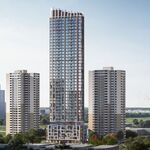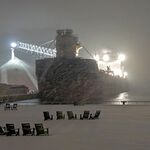Follow up article on yesterday's financial post "Toronto's condo boom about to bust: report"
Toronto condo market seen as overheated
The Toronto condo market appears to be overheating and could soon be flooded with excess supply, says a new report from Bank of America Merrill Lynch Global Research.
The report is a rare warning in a condo market that most analysts say will continue to be supported by low rental vacancy rates and strong investor demand.
The market for condominiums in Canada's biggest city could undergo a significant correction and stagnant construction over the next several years, economists Ryan Bohren and Sheryl King say in the report.
"We think investors are underestimating the wall of inventory about to come on the market in the next 12-24 months, which could dampen price appreciation and investor returns," the authors said, adding Toronto could follow the path set by a recent overbuild in Kelowna, B.C.
They say multi-unit-dwell-ing construction across the country has surged back to record peaks. Toronto in particular has seen the strongest condo boom in more than a decade, with record numbers of units under construction. They noted that anecdotal evidence suggests up to 60% of preconstruction sales in the city are to investors.
The natural household formation rate for Toronto is estimated at 30,000 to 35,000 annually and apartments historically represent about 35% of that, or 12,000, the authors say.
"With apartment completions currently running at 18,000 and 37,000 condo units currently under construction, there is about 4.8 years' worth of inventory in the pipeline," Mr. Bohren and Ms. King say. That supply about to hit the market could put downward pressure on resale prices and rents.
However,ShaunHildebrand, Canada Mortgage and Housing Corp.'s senior market analyst for the Greater Toronto Area, said several factors suggest the risk of a correction is overblown despite the record number of condo completions in the works for this year and next.
For instance, more than 95% of units completed are sold, he said, leaving little risk of rising unsold inventory.
High-rise construction is also picking up the slack left behind by a drop in low-rise construction (such as singles, semis and row houses), he said. "We'll be looking more toward condos to ensure we keep up with household formation."
The rental vacancy rate in Toronto was 1.6% in April, one of the lowest in the country, CMHC says. Canada as a whole was 2.5%. With purpose-built rental apartments representing less than 10% of total apartment starts, Mr. Hildebrand said condos represent the only source of new rental supply, and will likely continue to meet with strong demand.
Ben Myers, editor and executive vice-president at Urbanation Inc., a group that monitors the Toronto condo market, agreed, pointing to recent media stories of bidding wars for rental listings.
"The condo rental market is extremely hot.. There is great demand for rental units and that's why investors are purchasing," Mr. Myers said.
"That isn't to say that prices will continue along their current path," Mr. Hildebrand said. "A flatter profile for demand and strength in supply will balance out the market and lead to much slower rates of appreciation. This should lead to a moderation in investor activity at preconstruction."
Acknowledging that it might be an extreme example, Mr. Bohren and Ms. King suggest a housing boom in Kelowna, B.C., where units under construction increased more than ninefold from 2000 to 2008, could serve as a warning for Toronto.
Demand collapsed during the recession but construction continued and inventories hit record levels, the authors say, noting that home prices remain about 15% below their 2008 peak in Kelowna.
But Mr. Myers said it is difficult to compare a large city such as Toronto with a small city such as Kelowna. Kelowna's rental rate was 6.6%, for example.
"You can't always draw the same conclusions from other markets. Most of the key indicators in the [Toronto condo] market right now are positive, so there really shouldn't be any talk about corrections or bubbles or anything like that."
http://www.financialpost.com/todays-paper/Toronto condo market seen overheated/5571375/story.html



